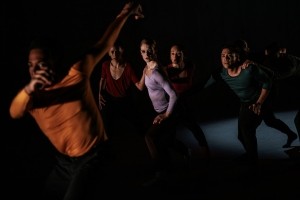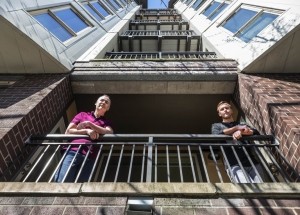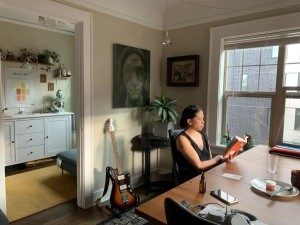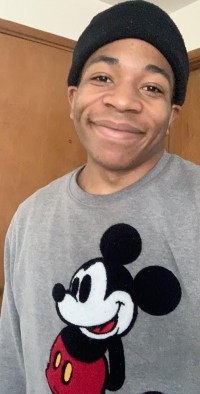“The dancers are incredible, kind and humble. They don’t look down their noses, arrogance doesn’t exist. That’s so obvious, and so rare,” says Melody O’Neill, Whim W’Him‘s patron services manager. It’s certainly been my experience as well with this company since its inception in 2009. And it is their strong personal empathy, along with the open, inquiring minds that complement their physical talents and skill, which will carry these dancers through present hard times and help them flower more than ever as artists in the future.
The lockdown season had a dramatic start for Whim W’Him, especially dancer Karl Watson and his partner Rob Williams, a commercial airline pilot. After several days of suffering from disquieting symptoms while traveling, Rob was able to get tested for Covid-19. That was on March 14th. Two days later his primary care clinic reported that he was coronavirus-free. The couple, and Karl’s fellow dancers, went on about their lives with a huge collective sigh of relief. But then a scary little momentary bad dream turned into a real life nightmare, when Rob was informed on March 20 that he did have the dreaded virus after all. This all took place just over the period when all the Whim W’Him dancers had spent several days with Olivier and choreographer Penny Saunders in an intensive dance retreat on Vashon Island rehearsing for the May program.
Long story short (you can read an expanded version in the Seattle Times: Seattle pilot’s misdiagnosis highlights challenges around coronavirus testing), Rob not only survived a severe and prolonged bout with the illness but is now quite well, and none of the dancers who were potentially exposed via Karl has developed any symptoms after four weeks of seclusion. But for all concerned, the episode certainly started off this viral spring with both a bang and a whimper. The dancers of Whim W’Him went into self-quarantine rather early, and of course like everyone else they are now still isolated.
Whenever the prohibition against non-essential businesses is lifted (what a peculiar world we live in, where alcohol and pot are considered essentials but art is not), the company, artistic director Olivier Wevers and Penny, will go into an ‘isolation cell’ where they can rehearse together during the days, then return home to their private lockdowns. Although I can’t talk about them yet, exciting plans are afoot for what will happen next, even if we are not yet free to attend live performances by May 29-June 6, when Whim W’Him’s XALT program is scheduled to go on.
During this great and unintended social experiment in which we are all participating whether we like it or not, how does the essential core of a small performing arts organization cope? As a dance troupe Whim W’Him is close-knit and over time has become a more and more unified ensemble, working together at an ever higher level. But what happens to esprit de corps and muscle memory when, as now, there is a long hiatus with no clear endpoint in sight? It’s been just about a month that Whim W’Him’s Stay Home has been in place. Yet from the very beginning, at first each day and now every other day, Olivier and the 7 current dancers have met electronically for about an hour and a half, telling stories, trading anecdotes from their lives or dancing careers, considering questions from silly to profound, sharing a song, a poem, a book, an album, and supporting each other in these trying times. Early on, they were joined by the two new dancers, who are slated to join the company in June (or whenever it’s possible after that) as Mia Monteabaro retires from Whim W’Him and Adrian Hoffman who is going back to LA to give himself time to explore how he wants to be performing and relating to dance moving forward.
One of the things that has come out of these online gatherings is a platform to help keep scattered dancers across the country and the world in touch with each other: #wedanceinterrupted set up by that Whim W’him dancers on Instagram is “A shared space for dancers around the world during a time of social distancing. As artist citizens, we continue to create while acting responsibly.
“Whim W’Him wishes to gather a community of dancers and creators to share clips from home of what they were working on to perform. A creative outlook to connect the dance world as we cope with isolation…
“1. Film a 30 second clip of where you left off—a rehearsal process, a performance—and post it to your page.
2. Use @danceinterrupted to tag us, as well as #wedanceinterrupted in your comments.
3. Pass it along—tag the partner from your duet, the company whose show you were performing with, the choreographer whose processed was interrupted.”
And now, especially as the interruption drags on, there is the ever present question of “How do you keep in shape?” (all these interactions were via email, text or phone chat, of course). All the dancers have their particular regimes of stretching and working out one way or another. Mia can use her backyard in good weather, Adrian’s apartment complex has a swimming pool. Others do what they can inside their apartments and go out on long walks, keeping their distance.
There is also a lot online to choose from, “classes on YouTube or Vimeo, via Zoom or IGTV, given by people I would never probably have worked with,” says Liane Aung, all sorts of styles and levels in which they can participate. Sometimes, she adds, the vast array of choices can be almost paralyzing. And yet, although it is all very well, as Olivier points out, to keep in solitary shape, in the end it’s no substitute for working in a large space in physical proximity and in relation to other dancers.
As for all of us in our different ways, the unique challenges of this moment pile onto the frustrations and worries of regular life. The company will continue to pay dancers’ salaries throughout the crisis with no break, but without supplemental income from waiting tables, playing piano for dance classes or teaching dance or Pilates, say, making ends meet can be tricky, even with a good dance contract like Whim W’Him’s.
And despite all the electronic connection it’s hard to be shut inside most of the time with no rehearsals or other usual occupations. Loneliness threatens if you live alone as a couple of the dancers do. On the other hand, being confined to a small place with a roommate or an other, no matter how significant, can feel too close at times. At least the weather has been more cooperative recently, and there is time to take up new projects or do things long put off, write poetry, make home-cooked meals, whatever—at least if you can summon the energy to get started (I know I often feel as if I am, or inhabit, a jellyfish, with no backbone or carapace but the continual possibility of a lethal sting). As Liane says, “Especially challenging is exactly that, the time at home drags on. The uncertainty of the end of social distancing and quarantining is challenging for me to comprehend.”
Karl adds,
It is natural for such highly trained and active dancers in the prime of their professional lives to chafe at the limitations, to bemoan the passage of time in a limbo state. They worry about being out of shape whenever rehearsals start up again. On occasion too much down time can stir up deep questioning of life and career choices.
But there are compensations as well, present truths to be realized. As Karl says, “I realize how much I love the closeness of the work we do at Whim W’Him; the physical, mental, and emotional closeness. Our work asks us to work in connection with one another on so many levels. I miss the feeling of having others ideas, thoughts, words, movements, and bodies near to me. I also realize how grateful I am to work in an expressive space. I love being able to physically and verbally express myself in the studio with colleagues I respect and trust. Being apart from them and trying to work at home, I am realizing how much I love that communal environment.”
Physical separation can bring about a new awareness of common humanity. The act of distancing can force a vital exploration of feelings that might never be confronted by choice. And, paradoxically, being apart can engender greater personal closeness and deeper understanding of the very fellow artists the dancers of Whim W’Him cannot (for now) dance with anymore.







